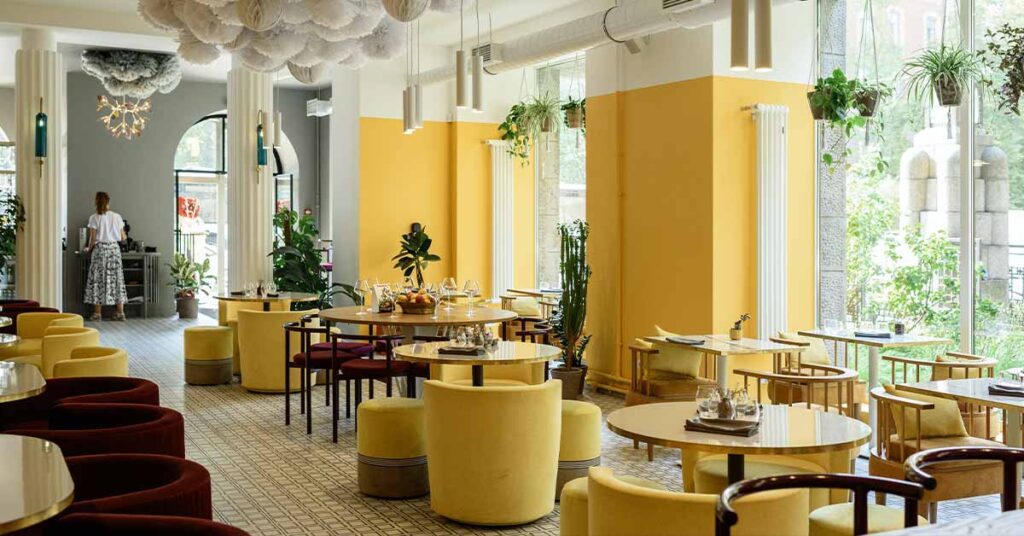In the highly competitive cafe industry, offering great coffee is only part of the equation. The ambiance and comfort level of a cafe play an equally significant role in determining customer retention. In recent years, cafes have evolved from places to grab a quick coffee to environments where people work, socialize, and relax. The design and layout of Cafe Interiors are critical factors in encouraging customers to stay longer, return frequently, and spread the word about their experience.
In this post, we will explore how comfort-focused Cafe Interiors can boost customer retention and why it’s essential for cafes to invest in thoughtful design.
1. Why Comfort is Key to Customer Retention in Cafes
Comfort is a primary driver of human behavior, especially in social spaces like cafes. A comfortable cafe interior can significantly influence how long customers stay and whether they return. Research shows that customers are more likely to revisit spaces that make them feel relaxed and welcome. When people feel at ease in a particular environment, they are not only likely to extend their visit but also recommend the place to others.
Comfort in Cafe Interiors is not just about plush seating; it encompasses everything from lighting and temperature to the overall ambiance. A well-designed cafe should appeal to all the senses, creating a cohesive experience that makes customers want to linger. For cafe owners, this translates into increased dwell time, higher sales per visit, and a loyal customer base.
2. Key Elements of a Comfortable Cafe Interior
Comfort in Cafe Interiors can be achieved through several design elements that work together to create an inviting atmosphere. Let’s explore some of these key components.
a. Seating Arrangements
Seating is one of the most critical aspects of comfort in Cafe Interiors. Offering a variety of seating options caters to different customer preferences. Some may prefer cozy armchairs, while others might opt for more upright chairs for working or eating. Additionally, ergonomics plays a huge role—chairs should be comfortable enough for customers to sit for extended periods without causing discomfort.
Spacing between tables and chairs is also vital to create a sense of privacy and comfort. Overcrowded seating can make customers feel cramped and uneasy, whereas spacious seating allows for better flow and a more relaxed atmosphere.
b. Lighting
Lighting sets the tone for the entire cafe interior. Soft, warm lighting creates a cozy ambiance, encouraging customers to relax. On the other hand, harsh, bright lights can make a space feel clinical and uncomfortable. Natural light is another important factor, as it contributes to an uplifting and refreshing atmosphere. A well-lit cafe, especially one with large windows, gives off a welcoming vibe that draws people in.
At night, dimmable lights can help create an intimate setting for customers who want to unwind after a long day. Effective lighting design can transform a cafe into a space where customers feel at home.
c. Temperature and Acoustics
Comfort also depends on physical factors like temperature and sound. A cafe that is too hot or too cold can quickly drive customers away. Temperature control should be managed carefully to ensure the space is neither stifling nor too chilly.
Similarly, acoustics can make or break the customer experience. Loud noise from clattering dishes or blaring music can make it hard for customers to relax. Sound-absorbing materials, such as rugs, curtains, or acoustic panels, help reduce noise levels, creating a quieter, more enjoyable atmosphere for conversations or solo relaxation.
d. Aesthetic Choices
A cafe’s aesthetic influences how comfortable a customer feels within the space. Neutral color palettes, soft textures, and natural materials can evoke feelings of warmth and comfort. Combining aesthetics with functionality, such as incorporating greenery, cozy textiles, and wooden elements, enhances the overall feel of the cafe. A well-designed aesthetic that aligns with the brand can make the space feel inviting and cohesive.
3. How Cafe Interiors Impact Customer Behavior
The design and layout of Cafe Interiors can directly impact customer behavior, especially in terms of how long they stay and what they do while in the space. A well-thought-out interior encourages customers to stay longer, which can lead to higher spending.
For example, a seating layout that offers privacy while still feeling open and inviting can make customers feel comfortable enough to linger for hours. This is especially true for customers looking to work or read, as they require comfortable seating and a quiet, distraction-free environment.
Similarly, cafes that design their spaces with a clear flow can influence customer behavior in positive ways. For example, placing seating near large windows can make the space feel more expansive and appealing, drawing people to those areas. Offering a mix of solo seating options and larger communal tables can accommodate both individuals and groups, catering to a wider range of customers and needs.
4. The Importance of Flexible Design in Cafe Interiors
One of the challenges cafes face is catering to a diverse group of customers, each with different preferences. Some customers may come for a quick coffee, while others may want to work for several hours. A flexible design is essential for meeting these varied needs.
Flexible Cafe Interiors are designed with versatility in mind. Modular seating, movable furniture, and multi-purpose spaces allow cafes to easily adapt to different uses. For instance, a cafe could have a quiet, relaxed area for people working on their laptops, while another section could cater to groups or families.
The ability to rearrange or adjust the space for events or changing customer traffic is also important. Flexibility enables cafe owners to create an environment that is comfortable for a wide range of customers, improving overall satisfaction and retention.
5. Case Studies: Cafes with Interiors Designed for Comfort
Several cafes around the world have excelled in creating comfort-driven interiors that boost customer retention. Here are a few examples:
- Cafe Nero: Known for its cozy atmosphere, Café Nero designs its spaces to be inviting and homely, with soft lighting, comfortable seating, and warm colors. These elements encourage customers to relax and spend more time at the cafe, whether they are socializing or working.
- Starbucks Reserve Roasteries: Starbucks has elevated its interiors in its Reserve Roasteries, blending high-end materials with comfortable seating arrangements. The focus is on creating a luxurious yet cozy environment where customers feel welcomed to linger and enjoy the space.
- Common Grounds, Dubai: This cafe in Dubai is a great example of how local cafes are blending style with comfort. With large windows that let in natural light, ample seating, and a minimalist yet cozy design, Common Grounds offers a space where customers feel comfortable spending long periods, whether catching up with friends or working solo.
These cafes prove that investing in comfort-focused interiors can significantly impact customer satisfaction and retention.
6. Practical Tips for Enhancing Comfort in Cafe Interiors
Cafe owners looking to enhance the comfort of their interiors can start with small changes that make a big difference:
- Invest in Quality Seating: Comfortable chairs and sofas are essential for a relaxed environment. Choose seating options that are both stylish and ergonomic.
- Create Zones: Divide the cafe into different zones based on customer needs. Offer quieter areas for work or study, and more vibrant sections for socializing.
- Use Warm Lighting: Switch to soft, warm lighting to create a cozy and welcoming atmosphere. Dimmer switches can help adjust the ambiance based on the time of day.
- Bring in Nature: Adding plants and greenery not only improves air quality but also contributes to a calming and comfortable environment.
- Maintain Cleanliness: A clean and well-organized space is crucial for customer comfort. Ensure that seating areas, restrooms, and service counters are spotless at all times.
Conclusion
In the competitive cafe industry, the design of Cafe Interiors can play a significant role in boosting customer retention. By focusing on comfort, cafe owners can create environments that encourage customers to stay longer, return frequently, and recommend the space to others. From seating arrangements and lighting to flexibility in design, every element contributes to the overall customer experience.
Cafes that invest in thoughtful, comfort-driven design will ultimately see the benefits in terms of customer loyalty and business success. Whether it’s through cozy seating, ambient lighting, or aesthetically pleasing decor, creating a comfortable cafe interior is a sure way to enhance customer satisfaction and retention.







